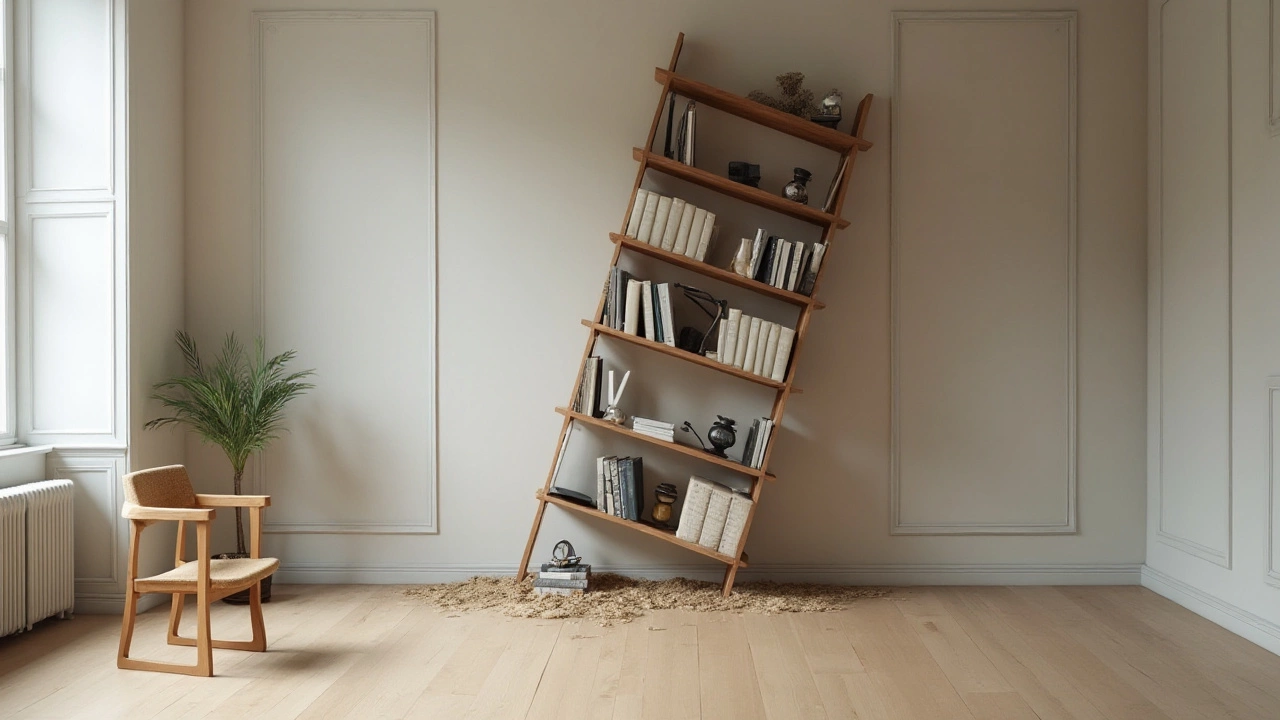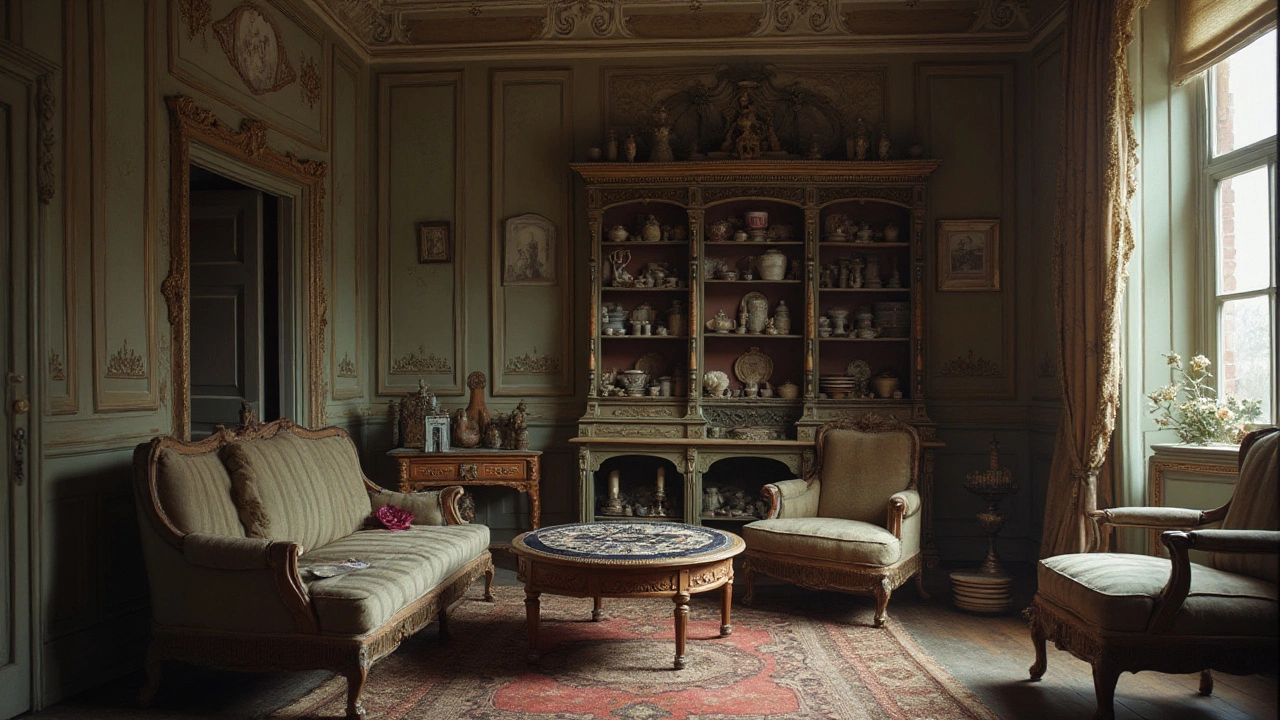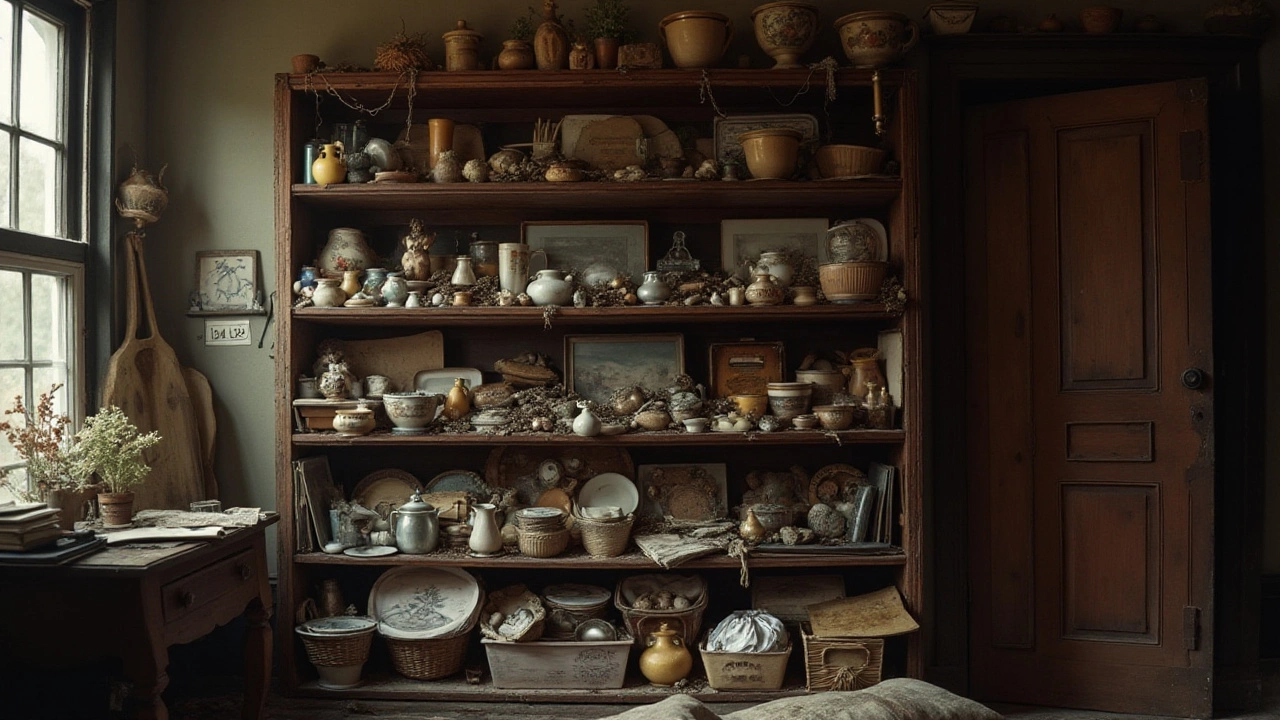Shelving can seem like a straightforward solution for storage and display needs, but it often carries hidden challenges. From setup issues to long-term maintenance woes, some drawbacks come into play that shapes our everyday experience with this common household feature.
Exploring these potential pitfalls helps not only in recognizing limitations but also in strategizing ways to mitigate them. The journey through understanding shelving's disadvantages begins with addressing the rigid confines of space limitations, moving through to the more nuanced aspects of design and utility deployment.
- Space Limitations and Flexibility
- Installation Challenges
- Maintenance and Upkeep
- Inefficiency with Storage Needs
- Aesthetic Concerns
Space Limitations and Flexibility
The concept of shelving seems deceptively simple at first glance. It offers the promise of efficient storage, an opportunity to declutter, and a means to elevate the aesthetic appeal of a room. However, the reality can be more complicated, particularly when we scratch the surface and dive into the limitations associated with space and flexibility. For starters, traditional shelving systems can impose rigid boundaries on available space. Their fixed structure often means you're working with a set size, which might not always align with your evolving storage demands. This lack of flexibility becomes immediately apparent when you try to store an oddly shaped item—a conundrum many of us have faced.
It's not just about the physical constraints. The visual implication of occupying vertical space can also become problematic. Large shelves can dominate a room, making it feel cramped and claustrophobic, which negates the intent of creating an open, freeing environment. The challenge is particularly pronounced in spaces with low ceilings or limited floor area, where every inch counts. A poorly chosen shelving system can do more harm than good, obstructing light and making a room appear smaller than it actually is. According to interior design experts at The Spruce, "choosing the right shelving can either open up a space or close it off." Shelving that is bulky, cluttered, or mismatched to the proportions of the room might close off the space visually.
Then, there’s the issue of adaptability. As your storage needs evolve, shelving rarely does. This inconsistency leads to substantial frustration, especially when seasonal items or new purchases come into play. Adjustable shelving systems do exist, but they often come with a higher price tag and can require complex installation processes that deter many from opting in.
Another person often overlooked aspect is the impact on home resale values. Built-in shelving can either be a selling point or a downfall, depending largely on its integration with the home's overall style and function. Potential buyers might see these fixed structures as restrictive, being unable to visualize how they would personalize the space to fit their own lifestyles.
Given these constraints, it's crucial to weigh your options carefully. If you are investing in shelving, ask yourself whether your chosen system will adapt over time. Consider future-proof solutions, like modular systems, which allow for restructuring and reconfiguration without starting from scratch. Evaluate if the space limitations are going to hinder the living quality or aesthetic balance of your home. Long-term plans are essential. The goal is to ensure that shelving supports your needs, rather than constraining them.
Installation Challenges
Installing shelving in your home or office is often far from a straightforward task. One might think it's just about screwing in brackets and placing shelves, but the reality unveils a suite of potential problems well before you pick up a screwdriver. Misjudging wall materials, improper leveling, or insufficient tools can transform potential storage solutions into real headaches. Moreover, if you're living in an older building, walls may sag or lack the necessary support to hold heavy weights, presenting unique challenges that can test the patience of even the most seasoned handymen.
To navigate these obstacles effectively, first consider the specific type of shelving you want to install. Each type, whether floating shelves, bracket shelves, or built-in units, brings its own set of intricacies. Floating shelves, for example, need clear marks for hidden hardware, and a misstep here could turn a sleek design into a precarious eyesore. That's why professional insight often advises checking for wall studs or utilizing proper anchors to avoid mishaps. "A shelf properly anchored can safely hold weight," notes handyman expert John Simpson, "but take care to measure and assess properly before installation."
"Remember, not every wall is the same, and knowing your home's structure can save you countless hours of frustration and expenditures." - Sarah Thornton, Interior Design Specialist
A crucial but frequently overlooked step is the planning phase: deciding where shelving should be and what items it will support. Planning reduces the error margins significantly. For instance, placing shelves at different heights can accommodate various object sizes, but varying load capacities could mean reinforcing certain sections with additional brackets or supports. Disregarding these considerations may result in uneven or wobbly installations, leading to dangerous situations or damaging your cherished belongings.
Consider also the tools at your disposal. Not everyone possesses a drill, level, or the suitable bits required for variable wall textures or diversities of mounting hardware. If you're less experienced or lack the proper kit, it could be worth hiring a professional or consulting someone knowledgeable to avoid costly mistakes. There's nothing quite like the disappointment of realizing, mid-project, that you've overlooked essential equipment or hardware. This can be preempted by thoroughly researching your shelving unit's requirements in tandem with the structural nature of your walls.
The Importance of Precision
Precision is key to overcoming installation issues. Small measurement errors can lead to shelves that tilt or don't hold securely, compromising both form and function. To add to the problem, many shelves come with minimal or unclear instructions, assuming a level of expertise that may not always be present. To counter this, it’s beneficial to sketch out your intended design and calculate load distribution before making any physical alterations to your living space. By ensuring everything is in its right place, future hurdles typically linked to installation are minimized, making the entire process not only more effective but significantly less stressful.In today's fast-paced world, every moment spent figuring out these installation challenges can feel arduous, which is why careful planning and execution help alleviate these burdens, creating efficient and aesthetically pleasing storage solutions that withstand time and use.

Maintenance and Upkeep
When it comes to shelving, one of the notable drawbacks revolves around the continuous task of maintenance and upkeep. Shelving solutions, whether intricate wall-mounted designs or standalone units, are prone to gathering dust and dirt over time. Routine cleaning becomes necessary, and it's not simply a matter of aesthetics but also hygiene. Over time, this buildup can affect the structures and items it holds, potentially causing discoloration to objects or even hastening wear on the shelves themselves. An interesting point to note is the choice of materials for shelving; wooden shelves might require different cleaning solutions and approaches compared to metal or glass ones, adding further complexity to this maintenance endeavor.
One might be surprised to learn that how shelving interacts with the environment plays a significant role in its upkeep. In many homes, shelves can encounter changes in room humidity and temperature, leading to warping or loosening of fittings, which progressively compromise the shelf’s integrity. Particularly in urban areas, particulates and pollutants settle quicker, necessitating regular cleaning sessions. A study by the Interior Design Association revealed that nearly 40% of homeowners had to replace their shelving units due to inadequate maintenance routines within a five-year period. This statistic alone underscores the importance of diligent upkeep.
Interestingly, maintenance extends beyond mere cleaning. Storage and organization should also be approached with a strategic mindset, to prevent overloading that could lead to premature sagging or buckling. It’s recommended to inspect the anchor points and joints frequently, ensuring they haven't become unsteady over time. As suggested by interior designer Sarah Jane in her book, "Creating Spaces You Love,"
"A little dedication to routine checks and balance can spare significant hassle down the line."This quote perfectly captures the forward-thinking nature of proper shelving maintenance.
Knowledge of proper cleaning methods can be instrumental in extending the life of both the shelves and their contents. For example, gentle dusting with microfiber cloths prevents scratches on sensitive surfaces, while regular vacuuming of the area can curb the buildup of allergens. For glass and metal shelves, an alcohol-based cleaner can help maintain a pristine surface. Considering all these points demonstrates that with careful attention, the challenges of maintenance can be mitigated. This approach helps in sustainably enhancing the appeal and utility of shelving as both a storage and decorative feature.
If you're curious about the financial implications of maintenance, note that neglect could lead to costly repairs or replacements. A modest investment in quality cleaning supplies and some periodic maintenance work might save your dollars in the long run while ensuring that the shelves continue to serve their intended purpose efficiently. For many homeowners, even simple changes in the way items are stored can greatly reduce the time spent on maintenance. Prioritizing access to frequently used items and ensuring proper weight distribution are small adjustments that can pay off significantly. Shelving, whether storage-centric or purely decorative, really does demand this level of attention to ensure its longevity and functionality.
Inefficiency with Storage Needs
When it comes to embracing the myriad possibilities for home organization, the concept of shelving often stands at the forefront of our minds. Yet, for all its promise, it can proving rather insufficient once faced with the diverse range of items needing storage. The static nature of most shelving systems means they lack the adaptability to expand or contract based on new, changing requirements. Thus, homeowners may find themselves puzzling over how to accommodate larger items or increasingly varied collections of personal treasures. While the aesthetic simplicity of open shelving charms many, its functional limits soon demand more robust solutions.
Stuck within such constraints, you may opt to stack items higher or deeper among the shelves to best utilize the available space, but this strategy does little beyond compromising access and creating a cumbersome jumble. This inconsistency in organization can turn an otherwise neat setup into a cluttered affair. Besides, dust and debris delight in settling onto any exposed surface, adding to housekeeping burdens. Beyond physical limitations, the static design of fixed shelves rarely matches the dynamic nature of our growing and evolving household needs. For example, a kitchen shelf installed five years ago might not suit the current collection of modern cooking gadgets or new pantry requirements.
An insightful quote from Marie Kondo encapsulates this issue: "Storage should reduce stress and save time, not create a burden." When keen to maximize storing potential, it's essential to consider adjustable shelf systems capable of adapting to frequent shuffles in household assortments. These options allow for custom configuration, ensuring that the furnishings evolve with our lives rather than acting as rigid frameworks.
In some cases, statistics provide a wake-up call to this shelving inadequacy. According to home organization studies, up to 80% of people feel disorganized at home, with about 60% of the trouble linked to insufficient storage efficiency. Assumed solutions lead only partially to new management methods, reaffirming the significance behind selecting shelves that meet not just aesthetic desires but ongoing practical requirements.
Developing a solution-oriented mindset and redefining what proper home storage entails can genuinely transform everyday living spaces. With shelves, it's not solely a matter of where items rest for display but how smoothly household traffic maneuvers around them. Encourage forward-thinking in design selection rather than settling for a setup that's appealing but ultimately inefficient for continuous usage.

Aesthetic Concerns
The role of shelving in home décor extends beyond its practical application; it is a defining factor of the room's visual appeal. A cluttered or mismatched shelving system can quickly become an eyesore, disrupting the harmony and style of a space. Choosing the right shelving involves a delicate balance between functionality and aesthetics. Missteps here can lead to visual chaos, with shelves that either overpower the room or appear out of place. Shelving that doesn't match the existing style can clash horribly, ruining the intended ambiance and making the room feel disconnected.
It’s not uncommon for individuals to overlook the importance of design consistency when installing shelves. For instance, clear glass shelves might look chic and modern, but paired incorrectly, they can appear cold or sterile rather than sleek. Similarly, rustic wooden shelves can add warmth and character but may look awkward in a minimalistic setting. Each material and design choice must be thought through not just individually, but how these elements integrate with the rest of the room’s decor.
"In design, there’s a saying: ‘It’s not what you look at that matters, it’s what you see.’ This holds especially true for shelving." - Famous interior designer, Nate Berkus.
Patterns of arrangement on the shelves themselves also contribute significantly to the room's aesthetics. Even the most beautiful shelves can become cluttered if overloaded or if items are not curated thoughtfully. Striking the right balance involves keeping the installation neither too packed nor too sparse, ensuring that it enhances rather than detracts from the desired vibe. Over-decorating shelving can lead to a visually cluttered area, while under-decorating can make it seem forgotten or unfinished.
Working with colors and textures also affects the general ambiance projected by shelving. Light-colored shelves in a room themed with earth tones might appear disconnected. The strategic use of colors can create cohesion; matching shelf color or material with other elements like furniture and paint can unify the space, making it more inviting. For example, a room with wooden floors and wooden shelves might provide a sense of warmth and continuity, promoting a serene and homely atmosphere.
Another factor to consider is the scale of the shelving. Proportion plays a pivotal role in room aesthetics. Shelves that are too large can overwhelm smaller spaces, while too small a shelving unit in a large room might appear insignificant or misplaced. Always ensure that the shelves match the relative size of the area.
According to a 2023 survey by the Home Design Institute, 45% of homeowners expressed dissatisfaction with their shelving after installation, primarily due to aesthetic mismatches. This statistic underscores the importance of thoughtful planning when incorporating shelving into a home. With careful planning, the shelving you choose can serve as both a practical storage solution and a stylish addition to your home, blending seamlessly into the aesthetic goals of your decor.

